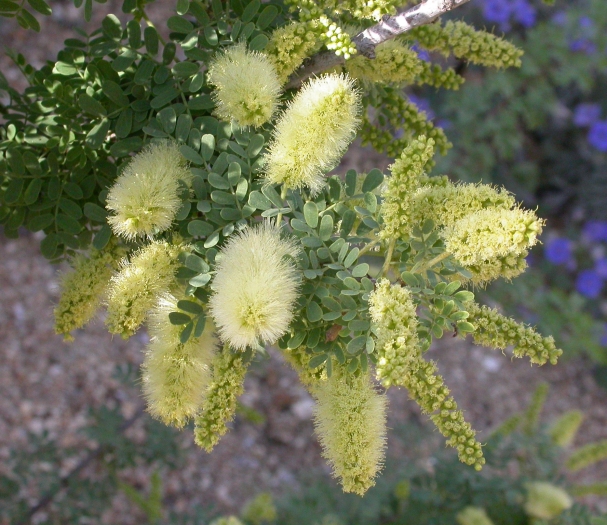Screwbean Mesquite
(Prosopis pubescens)
Screwbean Mesquite (Prosopis pubescens)
/
/

Curtis Clark assumed
CC BY-SA 2.5
Image By:
Curtis Clark assumed
Recorded By:
Copyright:
CC BY-SA 2.5
Copyright Notice:
Photo by: Curtis Clark assumed | License Type: CC BY-SA 2.5 | License URL: https://creativecommons.org/licenses/by-sa/2.5 | Uploader: Curtis Clark | Publisher: Wikimedia Commons | Title: Prosopis_pubescens_inflorescence_2003-06-02.jpg | Notes: Uploaded own work with UploadWizard |













































Estimated Native Range
Summary
Prosopis pubescens, commonly known as Screwbean Mesquite, is a deciduous tree or large shrub native to desert washes, riparian woodlands, and mesquite bosques in the Southwestern USA and Northwest Mexico. It typically grows to about 23 feet (7 meters) in height. Screwbean Mesquite is characterized by its light brown, furrowed bark and short, straight spines that are 1 to 3 centimeters long. The twice-compound leaves are feathery in appearance, and the plant produces numerous small yellowish flowers in elongate spikes during the spring and early summer. The flowers are moderately showy and attract pollinators. The distinctive tightly twisted seedpods, which resemble turned screws, are up to 5 centimeters long and are an evolutionary adaptation to deter seed predators.
Screwbean Mesquite is valued for its unique seedpods and adaptability to harsh environments, making it suitable for xeriscaping and wildlife gardens. It is also used for erosion control and as a windbreak in arid regions. This species is tolerant of drought and high temperatures, requiring full sun and well-drained soils. It can be grown in poor soils and is relatively low-maintenance once established. The seeds are a traditional food source for indigenous peoples and are still used today in various culinary applications. However, Screwbean Mesquite can be invasive in some areas outside its native range and may spread aggressively if conditions are favorable. It is also susceptible to a fungal disease called Texas root rot (Phymatotrichopsis omnivora).CC BY-SA 4.0
Screwbean Mesquite is valued for its unique seedpods and adaptability to harsh environments, making it suitable for xeriscaping and wildlife gardens. It is also used for erosion control and as a windbreak in arid regions. This species is tolerant of drought and high temperatures, requiring full sun and well-drained soils. It can be grown in poor soils and is relatively low-maintenance once established. The seeds are a traditional food source for indigenous peoples and are still used today in various culinary applications. However, Screwbean Mesquite can be invasive in some areas outside its native range and may spread aggressively if conditions are favorable. It is also susceptible to a fungal disease called Texas root rot (Phymatotrichopsis omnivora).CC BY-SA 4.0
Plant Description
- Plant Type: Tree, Shrub
- Height: 15-25 feet
- Width: 15-24 feet
- Growth Rate: Rapid
- Flower Color: N/A
- Flowering Season: Spring
- Leaf Retention: Deciduous
Growth Requirements
- Sun: Full Sun
- Water: Medium
- Drainage: Fast
Common Uses
Bee Garden, Bird Garden, Butterfly Garden, Edible*Disclaimer: Easyscape's listed plant edibility is for informational use. Always verify the safety and proper identification of any plant before consumption., Low Maintenance
Natural Habitat
Desert washes, riparian woodlands, and mesquite bosques
Other Names
Common Names: Screwbean, Screw Bean, Screw-Bean, Tornillo
Scientific Names: , Prosopis pubescens, Prosopis odorata, Prosopis emoryi, Strombocarpa pubescens, Strombocarpa brevifolia, Strombocarpa odorata,
GBIF Accepted Name: Prosopis pubescens Benth.